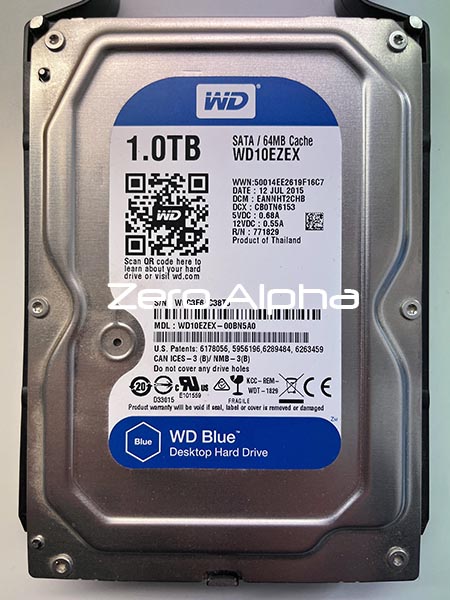Western Digital WD10EZEX Data Recovery
The Western Digital WD10EZEX is a popular 1TB hard drive, widely used for its reliability and affordability. As with any storage device, data loss can occur due to various reasons, ranging from physical damage to logical failures. This article delves into the challenges and common issues associated with data recovery from the Western Digital WD10EZEX hard drive, providing insights into what can go wrong and how these problems impact data recovery efforts.

Hard drive data recovery involves retrieving lost, corrupted, or inaccessible data from a malfunctioning or damaged hard drive. The process can be complex, especially when dealing with issues specific to certain models like the WD10EZEX. Recovery efforts typically depend on the nature and extent of the damage.
WD10EZEX Common problems
1. Physical Damage
Physical damage is one of the most common reasons for data loss in hard drives. The WD10EZEX, being a mechanical device, is vulnerable to several physical issues:
- Head Crash: The read/write head of the drive can come into contact with the platter surface, causing scratches and potentially leading to data loss. This can occur due to shock, such as dropping the drive.
- Spindle Motor Failure: The spindle motor, which spins the platters, can fail due to mechanical wear or electrical issues, rendering the drive inoperative.
- Platter Damage: Physical impacts or contamination can damage the platters, leading to data corruption or loss in the affected areas.
Recovering data from a physically damaged drive often requires specialized equipment and a cleanroom environment to prevent further damage and contamination.
2. Firmware Corruption
Firmware is essential for the operation of the hard drive, managing various tasks such as read/write operations, error correction, and data management. The WD10EZEX can suffer from firmware issues, which can cause the following problems:
- Firmware Crashes: Corrupted firmware can cause the drive to become unresponsive or prevent it from being detected by the system.
- Failed Firmware Updates: Incomplete or incorrect firmware updates can lead to malfunction, resulting in data inaccessibility or loss.
Data recovery in cases of firmware corruption typically involves using specialized tools to repair or bypass the corrupted firmware.
3. Mechanical Failures
The WD10EZEX, like other mechanical hard drives, can experience various mechanical failures that complicate data recovery:
- Bearing Failure: Bearings within the drive can wear out or fail, preventing the platters from spinning correctly.
- Actuator Arm Failure: The actuator arm, which moves the read/write heads across the platters, can become stuck or fail, leading to data inaccessibility.
- Vibration Damage: Excessive vibration or shock can cause misalignment or damage to internal components, impacting the drive's functionality.
Recovering data from a drive with mechanical failures often requires disassembly and repair of the internal components, a task best left to professionals with the necessary expertise and equipment.
4. Logical Failures
Logical failures refer to issues related to the data structure or file system rather than physical damage. The WD10EZEX can experience several logical issues, including:
- File System Corruption: Power failures, improper shutdowns, or software errors can corrupt the file system, making the data unreadable by the operating system.
- Accidental Deletion: Users may accidentally delete important files or format the drive, leading to data loss.
- Bad Sectors: Over time, drives can develop bad sectors, which are areas of the disk that are unreadable or damaged, leading to data loss or corruption in those areas.
Data recovery from logical failures can sometimes be performed using software tools, but the effectiveness depends on the extent of the corruption and whether the data has been overwritten.
5. PCB (Printed Circuit Board) Failures
The PCB is responsible for controlling the drive's functions and communication with the computer. The WD10EZEX can encounter PCB-related issues that impact data recovery:
- Electrical Damage: Power surges or electrostatic discharge can damage the PCB, preventing the drive from functioning.
- Component Failure: Individual components on the PCB, such as capacitors or transistors, can fail, leading to data inaccessibility.
Recovering data from a drive with a failed PCB often involves either repairing the PCB or replacing it with an identical one, which requires precise matching due to unique firmware and calibration data.
6. Overheating Issues
Overheating can significantly affect the performance and lifespan of the WD10EZEX. Common overheating problems include:
- Thermal Expansion: Prolonged exposure to high temperatures can cause thermal expansion, leading to mechanical misalignment or failure.
- Component Degradation: High temperatures can degrade electronic components, causing them to fail or function erratically.
Preventing overheating by ensuring proper ventilation and cooling is crucial, but once overheating has caused damage, data recovery can be complicated.
7. Magnetic Degradation
Hard drives like the WD10EZEX use magnetic storage to record data on the platters. Over time, the magnetic properties can degrade, leading to data loss or corruption. Common issues include:
- Bit Rot: This refers to the gradual degradation of the magnetic signals on the disk, which can lead to data corruption.
- Demagnetization: Exposure to strong magnetic fields can disrupt or erase the data stored on the platters.
Data recovery from magnetic degradation often involves reading the remaining signals and attempting to reconstruct the lost or corrupted data, a process that can be technically challenging.
Data recovery from the Western Digital WD10EZEX hard drive can be a complex and multifaceted process due to the variety of potential issues. From physical and mechanical failures to logical and firmware problems, each scenario requires a unique approach and often specialized tools and expertise. Users facing data loss should be aware of these challenges and consider professional data recovery services to maximize the chances of a successful recovery. Regular backups and careful handling of the hard drive are essential preventive measures to avoid the need for data recovery in the first place.